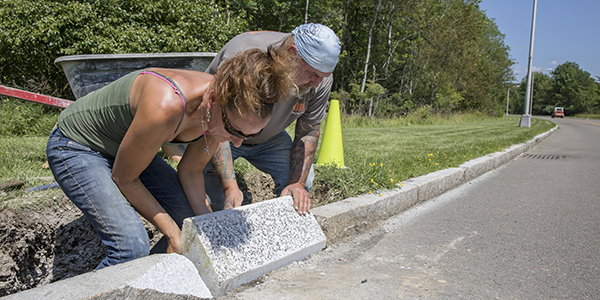Ramps enable annual salamander migration
Connector Road also closed from 6 p.m. to 6 a.m. first two weeks of November

We’ve all heard the joke, “Why did the chicken cross the road? … To get to the other side.”
At Binghamton University, a slew of 8-10 inch yellow-spotted salamanders do the same thing each fall and spring, prompting construction of special ramps and the temporary closing of the Connector Road that runs past and behind Hinman Community and Mountainview College to intersect with East Access Road on the other side of campus.
The salamanders – nicknamed mole salamanders because most of the year they live in the forest underneath the ground in mole and mouse holes – are driven to reproduce in vernal pools in the Nature Preserve, and need the safety provided by the ramps and the road closure to migrate there from the other side of the road. Without the ramps, the salamanders are unable to navigate the curbs and die of dehydration in the morning sun.
“The new ramps are far superior to the old asphalt ones,” Horvath said. “In the past, the salamanders would hit them and go over the asphalt and right into the road, but now the ramps are cut into the curbs and that allows for plowing and is a safety mechanism for the salamanders. And they do use them.”
In addition to the ramps, the Connector Road is only open from 6 a.m. to 6 p.m. the first two weeks of November and the entire month of April each year, when salamanders are migrating to or from their homes in the forest area behind CIW. It’s closed the entire month of March as well, to allow for the spring migration and to avoid any need to salt the road for vehicles.
Dylan Horvath, steward of natural areas on campus, said the yellow-spotted salamanders are considered common, but are almost extinct locally. “They have relatives that are in danger,” he said. “And these spotted salamanders have pockets of extinction because their habitat has been lost.”
Horvath is in his 13th year as steward, and has studied the salamanders since he was a student at Binghamton, where he earned both his bachelor’s and master’s degrees in biological sciences.
The salamanders usually migrate from the forest to the Nature Preserve on the first warm, rainy night in the spring, he said, traveling about 100 yards a night. “They can’t cross in the daytime because there are too many predators,” he said. “A wet, rainy night is better, after a couple nights of around 40 degrees when everything is thawing.
“They have to find a water body to reproduce in and normally like vernal pools – a pool of water made by rain – and usually in the woods,” Horvath said. “They’re places that usually dry up in the summer at some point and so there are no fish in them, so if the salamanders lay eggs in them, there won’t be fish to decimate them.”
Horvath said that much of the salamander population that crosses the Connector Road from behind CIW actually goes to the ditch alongside the Nature Preserve. “In general, they’ll try to find wherever they were hatched,” he said. “They do that by chemical cues, kind of like smelling, but using chemical cues and the soil and the air. I have pictures of some males actually in the yoga cobra position where they seem to be sniffing the air.”
Males usually cross the road first, Horvath said, to find the prime spots to wait for the females.
“When they get to the water, they have a neat courting system,” Horvath said. ”The females already have eggs that need to be fertilized, which is another reason why they need the ramps at the curbs because they have trouble climbing.”
The reproduction process takes a few weeks and when the courting is over, the females lay balls of jellylike egg masses in or at the edge of the vernal pools. “You can often see them on the surface or ideally about six inches below the surface of these pools, and they’re usually attached to submerged sticks and logs or whatever is in the water,” Horvath said.
The courting itself is surprising. “They don’t actually mate,” Horvath said. “The male will leave a sperm packet as part of the courting system and attract the female to pick it up. And the male really has to court the female to attract her. He rubs his nose on the female, swims in different patterns and generally tries to show he’s the most-healthy one.”
But the migration process still holds some mystery. “After the courting, we have trouble predicting when the salamanders will go back to the forest. Some of the males go back the same night and others might stay the entire summer,” Horvath said. “Dale Madison, [professor emeritus of biological sciences who implemented the original ramps in 1978, and the closing of the road each spring], found that the migration back was staggered and highly varied. Some go back slowly, almost like they’re reluctant to go back underground.”
Horvath recalled nights years ago when he would see 15 salamanders crossing the road at once, with a total of 75 on one particular night. “Now, we have climate change and the weather has changed so we get late snows and cold nights in the spring, so we haven’t had that impressive a migration since we started gathering data,” he said. “Now, a wave will come and then other waves. The spring migration used to take one or two nights and now it can take a couple of weeks because it has to be wet for them to cross.”
But Horvath still has a text and call list to contact people interested in watching as much of the migration as possible. The peak time for salamanders to cross the road, he said, is from about 8:30 p.m. to midnight.

